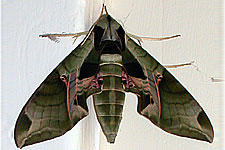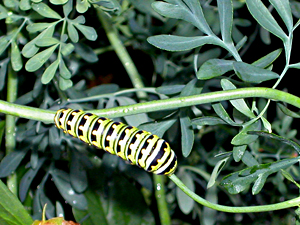 Last year, I posted this picture of a scary-big moth that flew into my house from the garden, and incorrectly called it a "Sphinx Moth," demonstrating my ongoing enthusiasm for, but lack of insight into, our arthropod friends. Well, last month, David M. emailed me with better information, and I thought you might want it, too (though he did not seem to want to receive credit by name).
Last year, I posted this picture of a scary-big moth that flew into my house from the garden, and incorrectly called it a "Sphinx Moth," demonstrating my ongoing enthusiasm for, but lack of insight into, our arthropod friends. Well, last month, David M. emailed me with better information, and I thought you might want it, too (though he did not seem to want to receive credit by name).[A]s to your bee keeping blog page that shows and mentions a visitor to your grape vine,
http://citybees.blogspot.com/2005_07_01_citybees_archive.html
That's not a (Macroglossini) Paonias excaecata, but rather I think is the Pandorus Sphinx, Macroglossini Eumorpha achemon.
http://bugguide.net/node/view/66501/bgpage (You may also find http://bugguide.net/node/view/3936/bgpage of interest.)
Your moth looks very similar to the Macroglossini moth that occurs from England through Hong Kong
and even at times into the Philippines and Australia, Daphnis neri.
http://www.ccs-hk.org/DM/butterfly/Sphingid/Daphnis-nerii.html
Now, of course we talked a bit more, to which he added:
"And, let the vine grow! It's a great food plant for quite a number of moth caterpillars, so you may see some other types munching away. Don't worry though, as you no doubt realize, they can't munch fast enough to damage the vine. 8-)
If you want to get into the swing of things, when you find some caterpillars on the vine, or on other plants you have, you can remove them to a large container with some leaves and observe their development and eventual adult form. Just keep the container clean; i.e. dump the caterpillar's "fras" out every couple of days. If the caterpillar has a small "horn" on the tail end, you might need to put a tissue in the container when it is getting ready to form a pupa, in order to substitute for soil. Some of the Sphinx moth types like to burrow underground before forming their pupa.
Meanwhile, if you find any other interesting bugs, you may look here
http://whatsthatbug.com/sphinx_moth_2.html for identification
or here: http://www.silkmoths.bizland.com/danjansphinx.htm
or here http://rusinsects.com/top/index.php?" for help figuring out what it is.
Have fun! Enjoy some honey!
David
 Now it's really cool that he mentioned all those identification resources, because only a month or so before, I had met this critter on a rue plant in the front yard. It turns out to be (probably...I am willing to hear other thoughts!) a Black Swallowtail Butterfly caterpillar. As I write to you today, the butterflies are here in force, making their way to winter pastures. There are many monarchs visiting rose of sharon blossoms, and yes, some Black Swallowtails in the front yard. I'm kind of hoping they did some growing up there.
Now it's really cool that he mentioned all those identification resources, because only a month or so before, I had met this critter on a rue plant in the front yard. It turns out to be (probably...I am willing to hear other thoughts!) a Black Swallowtail Butterfly caterpillar. As I write to you today, the butterflies are here in force, making their way to winter pastures. There are many monarchs visiting rose of sharon blossoms, and yes, some Black Swallowtails in the front yard. I'm kind of hoping they did some growing up there.
No comments:
Post a Comment